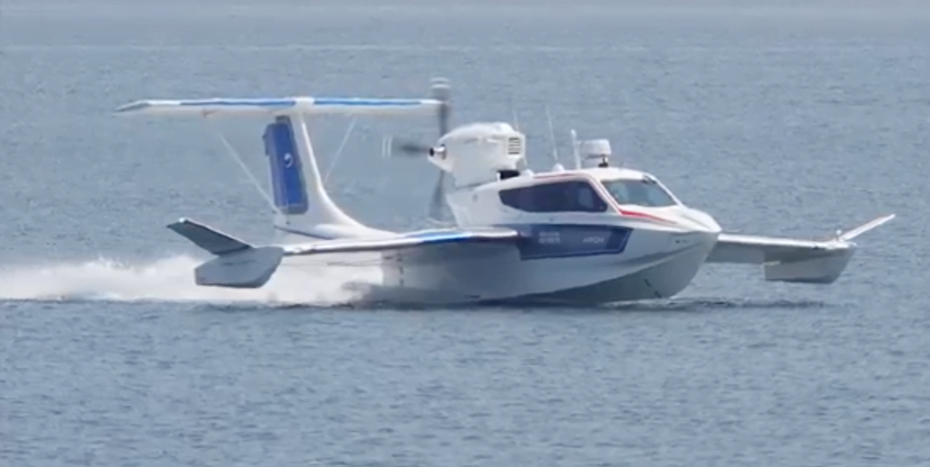 A company named Canary Islands WIGs (Ciwigs) aims to start a fast transport service from Las Palmas de Gran Canaria to Santa Cruz de Tenerife that will operate out of existing ports using low-flying ships, that will take less than half an hour to complete the journey. All that currently stands in their way is the need for specific regulation and guidance on how these crafts are to operate.
A company named Canary Islands WIGs (Ciwigs) aims to start a fast transport service from Las Palmas de Gran Canaria to Santa Cruz de Tenerife that will operate out of existing ports using low-flying ships, that will take less than half an hour to complete the journey. All that currently stands in their way is the need for specific regulation and guidance on how these crafts are to operate.
These vessels that look like aircraft, however from a legal standpoint, they are in fact boats, better known as GEVs (Ground Effect Vehicles) or a WIG (Wing In Ground Effect) that make use of an aerodynamic force, known as the ground effect, to travel at speeds of close to 200 kilometres per hour without touching the sea during travel. It is the dynamic interaction generated between their wings and the surface of the water that forms a kind of air cushion, allowing the craft to travel at high velocity, with little resistance, and relatively small fuel efficient engines.
New Flying Boat Service for Las Palmas de Gran Canaria & Tenerife
The New Flying Boat Service planned for Las Palmas de Gran Canaria & Tenerife aims to start operations in 2021 if all goes well with pilot tests next year.
#FlyingBoats #WIGs #CIWIGs #GranCanaria
Video courtesy of Aron Flying Ship.,LTD 아론비행선박산업
Posted by The Canary News on Saturday, April 6, 2019
 The first craft is expected to arrive on the Islands during the summer of 2020, in order to carry out a pilot tests authorised by the General Directorate of the Merchant Navy before being allowed to start regular operations. The company behind the initiative plans to begin commercial operations around June 2021 , once they have managed to overcome all the legal procedures necessary for its implementation.
The first craft is expected to arrive on the Islands during the summer of 2020, in order to carry out a pilot tests authorised by the General Directorate of the Merchant Navy before being allowed to start regular operations. The company behind the initiative plans to begin commercial operations around June 2021 , once they have managed to overcome all the legal procedures necessary for its implementation.
“The first route in the world with low-flying ships will be inaugurated in Korea this year and we hope that the second one will be in the Canary Islands”, explains the manager of Ciwigs, Gerardo Morales Hierro. In fact, the WIGs that they plan to bring to the archipelago are themselves Korean, created by specialist firm the Aron Flying Ship company, which has developed the first commercial prototype of these flying boats suitable for the transport of passengers, and who hope to begin operating between the South Korean peninsular city of Pohang and the island of Ulleung at around the same time.
 These vehicles are not a new invention. The Russian military were using them in the 1970s, and many others have been built since. However this is the first specifically built for passenger operation. The main obstacle to the company starting operations is now regulatory, says Morales Hierro. The IMO (International Maritime Organisation) published their first guidelines about these types of craft back in 2002 and updated them again last year, however there is still no state regulation that adapts the IMO guidelines to the Spanish legal framework.
These vehicles are not a new invention. The Russian military were using them in the 1970s, and many others have been built since. However this is the first specifically built for passenger operation. The main obstacle to the company starting operations is now regulatory, says Morales Hierro. The IMO (International Maritime Organisation) published their first guidelines about these types of craft back in 2002 and updated them again last year, however there is still no state regulation that adapts the IMO guidelines to the Spanish legal framework.
Since the end of 2017, a working group composed of various experts from the Merchant Navy, the IMO, the National Institute of Aerospace Technology and Canary Islands WIGs themselves have been drafting a proposal for formal state regulations. The document was presented this week to the general director of the Merchant Navy, Benito Núñez Quintanilla, and to the vice president and transport adviser for the Government of the Canary Islands, Pablo Rodríguez, who will now start a legislative process in Madrid to have these vehicles recognised and regulated under Spanish law.
 Canary Islands WIGs have ordered four M80 WIGs for operations between the two Canarian capitals, each able to carry up to eight people, including two crew, using a 750-horsepower engine. The craft have a maximum range of up to 650 kilometres due to the much more efficient use of fuel, far better than any helicopter or ship, according to the manufacturer, Aron.
Canary Islands WIGs have ordered four M80 WIGs for operations between the two Canarian capitals, each able to carry up to eight people, including two crew, using a 750-horsepower engine. The craft have a maximum range of up to 650 kilometres due to the much more efficient use of fuel, far better than any helicopter or ship, according to the manufacturer, Aron.
The company has made plans to operate 40 trips a day in each direction, with a new departure every 20 minutes, between the two main ports of the Archipelago, and only in daylight hours. During the winter months, the Ciwigs will be scheduled to operate between 7 am and 6.30 pm and in the summer, between 7 am and 8 pm. Although the fares have not yet been confirmed, tickets are expected to cost around €50 return for Canarian residents, Morales Hierro added.
 WIG craft do not require any additional port infrastructure as they can land on simply pontoons. They are able to take off within a surface of just 500 meters and can avoid storm weather or rough seas by climbing up to 100 meters above sea level. should the engines fail, the craft is designed to return to the surface, by gliding, and have been built in such a way as to minimise any possibility of rollovers on impact.
WIG craft do not require any additional port infrastructure as they can land on simply pontoons. They are able to take off within a surface of just 500 meters and can avoid storm weather or rough seas by climbing up to 100 meters above sea level. should the engines fail, the craft is designed to return to the surface, by gliding, and have been built in such a way as to minimise any possibility of rollovers on impact.
We don’t know if this latest exciting project will get off the ground, but it appears that the technology is ready, the project has plenty of institutional backing, and now just needs a legal framework in which to begin operations. If all is well we could be seeing travel times and costs between the two capitals significantly lessened by 2021.
The Canary Guide
Advertise your business to English Speakers on Gran Canaria
We have a range of exciting advertising opportunities starting from as little as 2€ a day online, having been in print for ten years we are now moving towards English language video and television, and with a regular audience reach of more than 50,000 people every week, 15-20,000 individuals come to our website every month 2-3 times a month.
Contact us by email on Publicidad@TheCanary.TV for more information

























